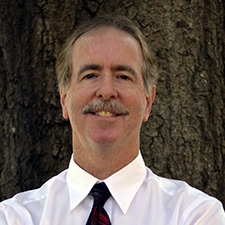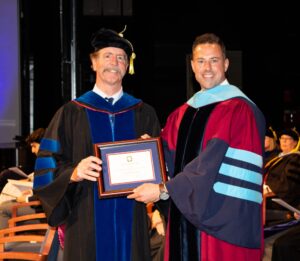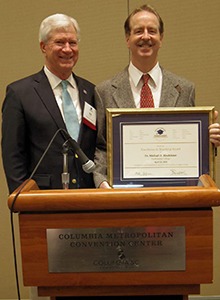
Michael Rischbieter , Ph.D.
Professor of Biology and Pre-Pharmacy Advisor
Department of Biology
Email Dr. Rischbieter(864) 833-8403
Dr. Rischbieter – Curriculum Vitae »
Education Background
Ph.D., University of South Carolina (Geology)
M.S., Western Illinois University (Biology)
B.S., University of Washington (Botany)
My Research Interests
Paleoecology of Carboniferous Coal Swamp floras in the midwestern and southeastern USA.
Palynology of the Pleistocene of South Carolina.
Biostratigraphy of Eocene/Oligocene mammals of the badlands near Douglas, Wyoming.
Courses I Teach
Biological Concepts (Biology 1150–Fall)
Organismal Biology (Biology 1151–Spring)
Seminar in Primary Biological Literature (Biology 2002–Fall)
Senior Seminar (Biology 4010–Fall or Spring)
Evolution (Biology 212–Spring Semester)
Paleontology (Biology 320–Fall Semesters)
Botany (Biology 203–Spring Semester)
Plant Systematics (Biology 206–Fall Semester)
Maymester ( Biology 4580–Natural History of the Galapagos Islands)
Research
My primary focus at this point is to involve students in the research process. My particular area of interest has been the Carboniferous paleoflora of the southeast. I have been actively collecting fossils from Virginia south through Georgia and west to Alabama. With student help, I have been attempting to reconstruct the change in plant communities in the southeast through geologic time. Along the way, students have been learning how to curate and maintain a paleobotanical collection, and how to manage a fossil database.
This past year, I was exceptionally lucky to stumble upon an amazing private collection of plant fossils while in Birmingham, Alabama, now called “The John Cooke Collection”. I have been actively involved over the past several months in getting the material curated, and have transported part of the collection to the Smithsonian Institution National Museum of Natural History, where these fossils will be used for research and display.
Another exciting line of research biology students and I have been involved in is the study of the palynology of the 450,000-year-old Pleistocene deposits from Harleyville, South Carolina. Three Honors Projects (Delaney and Hayne [2004], and Beaty [2005], and Sheppard [2006]) have focused on the environmental interpretation made possible by the extensive palynoflora present in these sediments. In an interesting twist on this research, I decided to test the working hypothesis of these paleoecosystem reconstructions by having students work on a modern pond ecosystem to see if the pollen and spores that were being deposited in the sediments of the pond reflected accurately the plants growing adjacent to the pond. Three Honor’s Research projects were the result of this idea: Carly Eargle, and Heather Hawkins [2008] worked on the palynology, and Nicholas Blake [2008] worked on the plant component of the surrounding pond environment.
Over the last four years, I have also been pursuing, along with a number of students, another line of research that centers around the Eocene and Oligocene mammals of the Badlands of Wyoming. I had the opportunity in 2007 to attend the TATE Conference in Casper, Wyoming, where I met Dr. Kent Sundell of Capser College. He leases approximately 10,000 acres of land near Douglas, Wyoming, which is right in the heart of the Badlands. The ‘badlands” are amazing topographic features that result from the actions of modern erosional forces cutting the mudstones deposited by the ancient Platte River, and is loaded with fossils, including oreodonts, horses, camels, nimravid “cats”, the huge suidArchaeotherium , and a myriad of smaller rodents. I returned with Dr. Inman and eight PC students in May 2008, and we spent several days collecting fossils in an untouched corner of Kent’s land which is controlled by the Bureau of Land Management (I had obtained a permit to do this!). Many of these fossils, encased in their mudstone tomb, are now being worked by students at PC. Allison Serdah completed a Honor’s project in 2008. Nick Plaisted also learned the techniques associated with preparing these fossils. More recently (2011), James Wilson completed a semester-long Internship learning how to use the airscribe to free fossils from the matrix. The ability to use the airscribe requiring fine-touch motor skills was especially useful to James in his aspirations of becoming a dentist after his 4 years at PC.
One other really interesting line of research that I began with Becca Miller two years ago, and will be continuing with Sydney Fontenot in the Fall of 2015 is the use of tree-ring analysis in understanding the nature of climate variability throughout the Pleistocene and Holocene Epochs. I am following the same approach as I did with the pollen and spore proxy data; we have been and will continue to take core samples from local trees to see if the tree ring measurements match the rainfall and temperature patterns recorded for this area. One interesting outcome of this research came from a pine tree I took a core from right next to Neville Hall. This tree turned out to be over 150 years old…predating the actual opening of Presbyterian College!!
Tree Campus USA-Arbor Day Foundation Interns
2022-2023 Eva Marie Hinkleman
2021-2022 Isabella Badon
2020-2021 Melinda Moore
2019-20 Andrew Whitney
2018-19 Paris Rizzo
2017-18 Danielle Gibson
2016-17 Morgan Morris
Summer Fellows Program Research Fellows
2022. Kenedie Conaway
2021. Jaden Yam
2020. Jaden Yam
2019. Adrianna Cody
2019. Sharmila Samuel
2018. Lexy Clark
2017. Victoria Cannon
2016. Sydney Fontenot
2014. Cassie Walker
2011. Caitlin Basnight
2011. Kaitlyn O’Gorman
Student Research (* Honors Research)
2024. Eva Marie Hinkleman. Establishing an Oak Master Chronology using COFECHA and ARSTAN.
2024. Morgan Berry. A Phylogenetic Analysis of the rare and endangered genus Harperella from the Janet Harrison High Pond Preserve in Monetta, South Carolina.
2024. SierraMarie Miller*. An Analysis of the Microwear Patterns in the genus Leptomeryx during the Eocene/Oligocene Transition in the Badlands of Wyoming.
2023. Morgan Berry*. A Survey of Plant Diversity and Analysis of Soils of the Janet Harrison High Pond Preserve in Monetta, South Carolina.
2023. Eva Marie Hinkleman*. Dendrochronology of Quercus alba (White Oak) in a montane ecosystem near Brevard, North Carolina.
2022-2023. Kenedie Conaway*. Morphological Comparison of Microfossils from the Peedee and Donoho Formations, Burches Ferry, Florence, South Carolina
2021-2022. Bailey Goforth*. A study of the dendroclimatic signal of loblolly pine (Pinus taeda) in the piedmont of South Carolina.
2021 Riley Swindell* A study of the microfossils of the upper Cretaceous PeeDee Formation.
2020-21 Jaden Yam* Paleopalynology of the Eocene/Oligocene Transition in the White River Badlands of Wyoming
2019-2020. Adrianna Cody*. An investigation of the relationship between white oak (Quercus alba) growth patterns and its corresponding soil microbiome in natural and urban environments in upstate South Carolina.
2019-2020. Sharmila Samuel *. A study of the phyllosphere associated with white oak (Quercus alba) in rural and urban environments in the piedmont of South Carolina.
2019. Adrianna Cody and Sharmila Samuel. A Study of White Oak (Quercus alba) Growth as Influenced by Environmental Factors. Summer Fellows 2019.
2019. Lexy Clark*. A study on the effects of urbanization on the dendroclimatic signal of White oak (Quercus alba) along the urban-rural gradient in the upstate of South Carolina.
2019. Channing Cox*. An SEM examination of the microwear patterns of the extinct canid Hesperocyon from the Oligocene White River Fm. of Wyoming.
2018. Lexy Clark. A study of the effects of urbanization as a proxy for climate change on the growth of white oak (Quercas alba). Summer Fellows 2018.
2018. Kassandra Glover*. The Paleopalynology of the Eocene/Oligocene Swan Lake Locality, Orin Wyoming
2017. Victoria E. Cannon. The Dendroclimatic Signal Found in Shortleaf Pine in the Piedmont of South Carolina. PC Summer Fellows Research Program.
2017. Allison Jenkins*. Using SEM and Light Microscopy to Analyze the Paleodiets of Hypertragulids of the White River Formation.
2017. Haleigh Mauldin*. Developing a Master Chronology for Quercus alba (White Oak)
2017. Austin Priaulx*. Using Morphometric Analysis to Determine the Taxonomy of Hypertragulids of the White River Formation.
2016. Sydney Fontenot*. A study of the dendroclimatic signal of white oak (Quercas alba) compared with the Palmer Drought Severity Index.
2016. Anna MacGregor*. Palynology and Biostratigraphy of the lower Permian Alfredo Wagner locality in Santa Catarina St., Brazil.
2016. Ivey Parr. An SEM study of dental microwear patterns of the Oligocene deer-like mammal Leptomeryx.
2015. Lauren Berkey*. Analysis of tooth-wear patterns in the Merycoidodontoidea from the Oligocene of Wyoming and Nebraska.
2014-15. Billy Joe Mullinax*. A study of the megaflora and palynoflora from the lower Permian of southeastern Brazil.
2014. Cassie Walker. The effect of drought conditions on complex information exchange in air and soil media of Phaseolus lunatus.Summer Fellows Research project.
2013. Becca Miller*. Testing the accuracy of dendroclimatology in a mixed deciduous-pine ecosystem in South Carolina.
2012. Caitlin Basnight*. Analysis of the paleodiet of 2 Oligocene-aged mammals of the White River Badlands using tooth striation microanalysis techniques.
2011. Caitlin Basnight. Reconstructing the paleoenvironment of the White River Formation of Wyoming based on the dentition of Oligocene-aged mammals. Summer Fellows Research project.
2011. Kaitlyn O’Gorman. Paleopathology of an Oligocene-aged camel jaw from the White River Formation of Wyoming. Summer Fellows Research project.
2011. Meghan Skinner*. Effects of CO2 on stomata density in Arabidopsis thaliana.
2010. Claire Hann. SEM and light microscopic analysis of the pollen and spores of the Young Pond depositional environment.
2009. Nick Plaisted. Techniques in fossil preparation.
2008. Nicholas Blake*. An ecological study of the relative density and relative dominance of the trees and understory plants contributing to the pollen rains in the pond sedimentary basins in and around Clinton SC.
2008. Carly Eargle*. An analysis of the pollen and spores contributing to the pond sediments in and around Clinton SC: light microscopy.
2008. Heather Hawkins*. An analysis of the pollen and spores contributing to the pond sediments in and around Clinton SC: electron microscopy.
2008. Allison Serdah*. The use of a modified air abrasion technique to analyze the structures used in the cladistic analysis of two Oligocene oreodonts.
2007. Sarah Cash*. A microfaunal analysis of the late Middle Pliocene Walrus Ditch Locality near Summerville, South Carolina.
2006. Danielle Gill*. Are the dinoflagellates of the Camelot Locality Eocene contamination or signs of a sea-level change in the Pleistocene?
2005. Anna Sheppard. An analysis of the dinoflagellates of the Camelot Locality sediments, Harleyville, South Carolina.
2004. Melissa Clare Beaty. A paleoenvironmental analysis of the Camelot Fauna Locality utilizing the angiosperm and gymnosperm component of the microflora.
2003. Laurel Delaney and Mary Douglas Hayne. A microfaunal analysis of the Pleistocene Camelot Locality of South Carolina.
1999. Matt Moore. An analysis of the Duplin Formation fossils, and a paleoenvironmental reconsideration of the Tearcoat Locality near Sumter, South Carolina
Publications, Articles, Abstracts and Presentations
2023. Kenedie Conaway and Michael O. Rischbieter. Benthic Foraminifera as Indicators of Sea Level Change Between the Donoho and Peedee Formations in Florence, South Carolina. Abstract, SC Upstate Research Symposium, USC-Upstate, South Carolina.
2022. Rischbieter,M, Neregato M, Iannuzzi R. New U-Pb zircon age-constrained flora from the Rio Bonito Formation (late Asselian) and implications for the biostratigraphy of the southern Paraná Basin, Brazil. J. South American Earth Sciences.
2022. Jaden Yam & Michael O. Rischbieter. “A New Paleoecological Reconstruction of the White River Badlands”. Abstract, National Conference on Undergraduate Research.
2021. Jaden Yam. Awarded “Best Oral Presentation; Natural Sciences II Division” for her presentation of the “Paleopalynology of the Eocene/Oligocene Transition in the White River Badlands of Wyoming”. South Carolina Upstate Research Symposium, USC-Upstate, South Carolina.
2021. Jaden Yam and Michael O. Rischbieter. Paleopalynology of the Eocene/Oligocene Transition in the White River Badlands of Wyoming. Abstract, SC Upstate Research Symposium, USC-Upstate, South Carolina
2020. Sharmila Samuel and Michael O. Rischbieter. A Study of White Oak (Quercus alba) Growth in Clinton, South Carolina. Abstract, SC Upstate Research Symposium, USC-Upstate, South Carolina
2020. Adrianna Cody and Michael O. Rischbieter. The Soil Microbiome of Quercus alba as Related to Annual Growth. Abstract, SC Upstate Research Symposium, USC-Upstate, South Carolina
2019. Lexy Clark and Michael Rischbieter. The effects of urbanization as a proxy for climate change on the dendroclimatic signal of White oak (Quercus alba) in the upstate of South Carolina. Abstract, SC Upstate Research Symposium, USC-Upstate, South Carolina
2018. Michael O. Rischbieter, “The palynology and paleobotany of the lower Permian Alfredo Wagner locality in Santa Catarina State, Brazil.” Tate Conference, Casper, Wyoming (invited speaker).
2018. Michael O. Rischbieter, “Perspectives on changes in science pedagogy over a 31 year teaching career.” Shift Internacional 2018 Conference, Universidad San Francisco de Quito, Quito Ecuador (invited speaker).
2018. M. Rischbieter, R. Neregato, M.M. di Pasquo, R. Iannuzzi, R. Alvarenga. “FIRST PALYNOLOGICAL AND PALEOBOTANICAL RECORDS OF THE UPPERMOST RIO BONITO FORMATION (LOWER PERMIAN, PARANÁ BASIN) IN ALFREDO WAGNER – SANTA CATARINA STATE, SOUTHERN BRAZI L.” XVII Simposio Argentino de Paleobotánica y Palinología (Paleobotany and Palynology Argentinian Symposium), Paraná, Argentina. (Abstract of presentation).
Fontenot, Sydney and Michael O. Rischbieter. 2016. “A study of the dendroclimatic signal of white oak (Quercas alba) compared with the Palmer Drought Severity Index.,” NCUR-UNC Asheville 30th Annual Conference Abstracts.
Michael T. Dunn, Prescott Atkinson, James Lacefield, and Michael Rischbieter, 2012. Winslowia tuscumbiana gen. et sp. nov. (Chaloneriaceae): A Cormose, Heterosporous, Ligulate Lycopsid Reconstructed from the Inside Out from the Pride Mountain Formation (Late Mississippian/Serpukhovian) of Northern Alabama. Int. J. Plant Sci. 173(1):96–111.
Carly Eargle and Michael O. Rischbieter, 2009. “An Analysis of the Pollen Profiles in Pond Deposition Basins and Associated Plant Community Structure in Young’s Pond, Clinton, SC”. Council of Undergraduate Research “Posters on the Hill” Abstract.
Eargle, C and M.O. Rischbieter, 2009. An analysis of the pollen and spores contributing to the pond sediments in and around Clinton SC . BigSURS Undergraduate Research Symposium Abstracts. UNC-Asheville.
Cash, S. and M.O. Rischbieter, 2007. A Microfaunal Analysis of the Walrus Ditch Locality. BigSURS Undergraduate Research Symposium Abstracts. Coastal Carolina University.
Rischbieter, M.O., Carpenter, J.R., and Saunders, O., 1996. Life Science Source Book: A guide to Life Science Activities, Vol. 1: Ecology. Center for Science Education, University of South Carolina, Columbia, S.C.
Rischbieter, M.O., Ryan, J.M., and Carpenter, J.R., 1993. “Use of microethnographic strategies to analyze some affective aspects of learning-cycle-based minicourses in paleontology for teachers.” Journal of Geological Education, v. 41, p. 208-218.
Rischbieter, M.O., and Stidd, B.M., 1985. Anatomically and morphologically preserved Linopteris obliqua Bunbury from the Herrin No. 6 Coal of Southern Illinois. Amer. J. Bot. Abstr., 72 (6): 899.
Stidd, B.M., Rischbieter, M.O., and Phillips, T.L., 1985. “A new lyginopterid pollen organ with alveolate pollen exines.” Amer. J. Bot., 72 (4): 501-508.
Rischbieter, M.O., Stidd, B.M., and Phillips, T.L., 1984. “A new seed fern pollen organ from the Pennsylvanian of Kentucky,” Amer. J. Bot. Abstr., 71(5/2):77.
DiMichele, W.A., Rischbieter, M.O., Eggert, D.L., Gastaldo, R.A., 1984. “Stem and leaf cuticle of Karinopteris: source of cuticles from the Indiana ‘paper’ coal,” Amer. J. Bot., 71(5): 626-637.
Awards & Honors

2022-2023 Robert H. Freymeyer Award for Meritorious Scholarship

Professor of the Year Award presentation at the SCICU meetings in April, 2018
